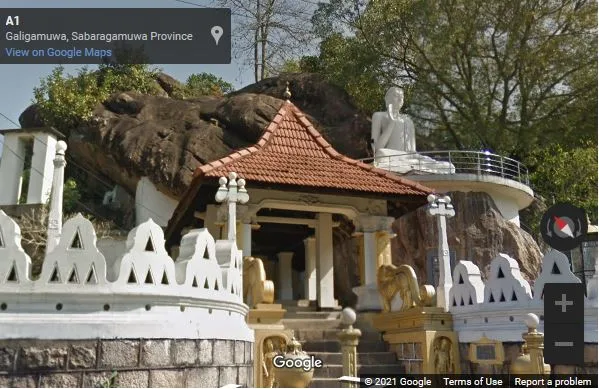
Bisowela Raja Maha Viharaya is a Buddhist temple situated in Bisowela in Kegalle District, Sri Lanka.
History
The cave of the Bisowela temple is thought to have been occupied by Buddhist monks since ancient times (Abeyawardana, 2002). This is evident by an inscription of Early Brahmi Characters (3rd century B.C.-1st century A.D.) that is found in the cave.
Bisowela Vihara cave inscription
Period: 3rd century B.C.-1st century A.D. Script: Early Brahmi Language: Old Sinhala
Transcript: Gapati Tilika Tisha-ma
Translation: .....of Householder Tilika Tissa
Citation: Gamage, 2020. p.36.
According to tradition, two queens (sisters) sheltered themselves in Handa-kele Mukalana in Bisowela village before the days of King Rajasinghe I [(1581-1593 A.D.) Bell, 1904]. It is said that the elder sister built the temple in Bisowela while the younger built a temple named Danduvalgane (Bell, 1904). During the reign of King Kirti Sri Rajasinghe (1747-1782 A.D.), the cave temple at Bisowela was restored by Pilimatalawe Maha Adhikari (Abeyawardana, 2002).
The cave temple
The cave temple is 15 ft. long and accommodates sculptures belonging to the Kandyan Period (Abeyawardana, 2002). Three seated Buddha statue in the posture of meditation is found inside it (Bell, 1904). The largest of them (8 ft. 9 in. by 7 ft. 8 in.) faces the entrance door while the other two (4 ft. 10 in. by 3 ft.) are positioned against the left and right walls (Bell, 1904). The walls are adorned with paintings depicting Buddhist themes.
A protected site
The drip-ledged cave (with the inscription) in the Bisowela Purana Gallen
Vihara situated in Bisowela village in the Divisional Secretary’s Division of Galigamuwa is
an
archaeological protected monument, declared by a government gazette
notification published on 8 July 2005.
References
1)
Abeyawardana, H.A.P., 2002. Heritage of Sabaragamuwa: Major natural,
cultural and historic sites. Sabaragamuwa Development Bank and The
Central Bank of Sri Lanka. ISBN: 955-575-077-7. pp.48-49.
2) Bell, H.C.P., 1904. Report on the Kegalle District of the Province of Sabaragamuwa. Archaeological Survey of Ceylon: XIX-1892. Government Press, Sri Lanka. p.33.
3) Gamage, D.P., 2020. Epigraphical Notes (Nos. 22-23). Department of Archaeology. ISBN: 978-955-7457-30-7. p.36.
2) Bell, H.C.P., 1904. Report on the Kegalle District of the Province of Sabaragamuwa. Archaeological Survey of Ceylon: XIX-1892. Government Press, Sri Lanka. p.33.
3) Gamage, D.P., 2020. Epigraphical Notes (Nos. 22-23). Department of Archaeology. ISBN: 978-955-7457-30-7. p.36.
4) The Gazette of the Democratic Socialist Republic of Sri Lanka, no: 1401. 8 July 2005.
Location Map
This page was last updated on 29 October2021
For a complete tourist map follow this link: Lankapradeepa Tourist Map
For a complete tourist map follow this link: Lankapradeepa Tourist Map

